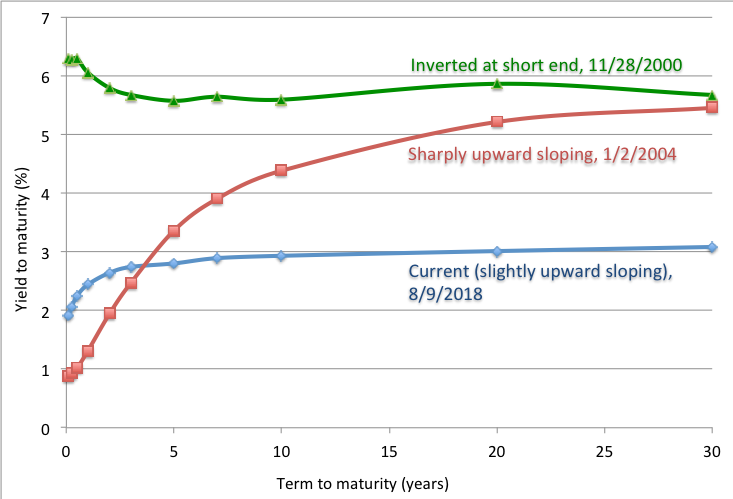For the first time in at least 40 years, there’s a fundamental economic reason that a yield curve near-inversion might not herald a recession. The U.S. Treasury yield curve is currently flatter than usual, not quite inverted but close enough to make some people nervous – since, in the past, recessions have almost always followed. I will make the case that it’s likely to be different this time.
[timeless]
Q2 hedge fund letters, conference, scoops etc
“This time is different” are the four words that make economic forecasters into monkeys, but see if you agree with my logic.
Yield curves – current, normal, and inverted
The U.S. Treasury bond yield curve is usually considered inverted when the yield on the two-year bond is higher than the yield on the 10-year bond. Other definitions are sometimes used, and I favor looking at even shorter maturities than the two-year because they’re more indicative of Federal Reserve policy, but the standard definition is good enough for this discussion. And it’s what most people focus on.
The two- to 10-year yield spread has narrowed to 25 basis points, which is not an inversion, but it’s close. Exhibit 1 compares the current situation to a more typical upwardly sloping yield curve shape and an inverted yield curve:
Exhibit 1: Current, upward sloping, and inverted yield curves
Source: Constructed by the author using data from treasury.gov. The 30-year yield for 2004 is extrapolated.
In the past, inverted yield curves and subsequent recessions have been closely associated, at least in the United States. The not-quite-inverted yield curve is prompting many commentators to ask whether a recession is imminent. Among them is an old master of the investment business, Charles Gave, who writes,
Should this [yield] spread move into negative territory, I would expect a financial accident to occur outside of the U.S., a U.S. recession, or possibly both. In the latter two scenarios, U.S. firms will no longer want to borrow and financial engineering will start to unravel. Zombie companies will fail and capital spending will be cut, as firms move to service debt and repay principal. Workers will get laid off and the economy will move into recession.1
This is especially problematic given how long-lasting the recovery from the 2007-2009 Great Recession has been. But it has also been an extraordinarily slow one, making it more likely – although not in any way guaranteeing – that it will last longer than past recoveries. So far, in terms of time it is the second longest economic expansion on record, but the economy has not been vigorous.
Read the full article here by Laurence B. Siegel, Advisor Perspectives


